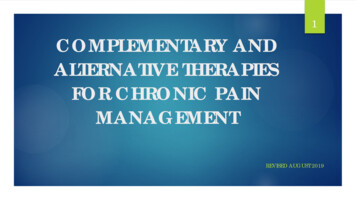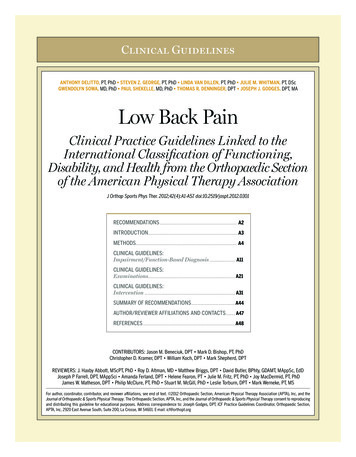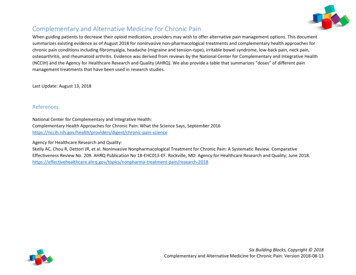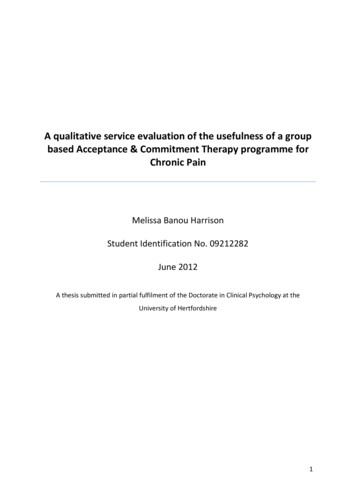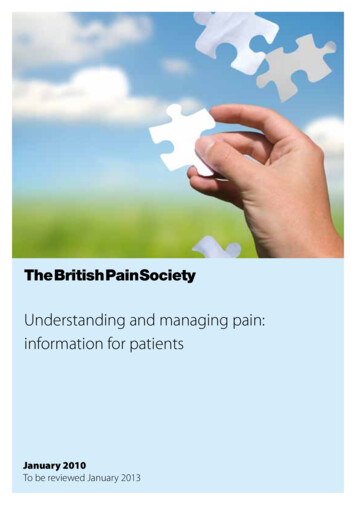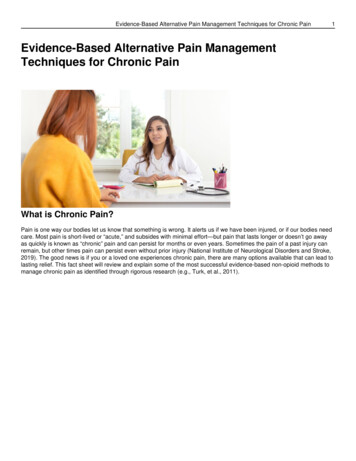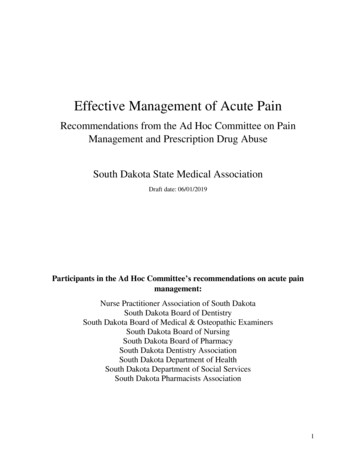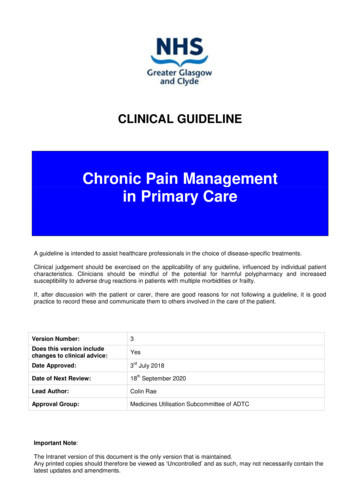
Transcription
CLINICAL GUIDELINEChronic Pain Managementin Primary CareA guideline is intended to assist healthcare professionals in the choice of disease-specific treatments.Clinical judgement should be exercised on the applicability of any guideline, influenced by individual patientcharacteristics. Clinicians should be mindful of the potential for harmful polypharmacy and increasedsusceptibility to adverse drug reactions in patients with multiple morbidities or frailty.If, after discussion with the patient or carer, there are good reasons for not following a guideline, it is goodpractice to record these and communicate them to others involved in the care of the patient.Version Number:3Does this version includechanges to clinical advice:YesDate Approved:3 July 2018Date of Next Review:18 September 2020Lead Author:Colin RaeApproval Group:Medicines Utilisation Subcommittee of ADTCrdthImportant Note:The Intranet version of this document is the only version that is maintained.Any printed copies should therefore be viewed as ‘Uncontrolled’ and as such, may not necessarily contain thelatest updates and amendments.
GUIDELINES FOR THE MANAGEMENT OFCHRONIC NON-MALIGNANT PAINThe Scottish Chronic Pain model outlines the vital role of primary and community care in themanagement of those with chronic pain. The aim of chronic pain management within these sectorsis to improve self care, health, functional ability, and to enhance a sense of living well with ongoingpain. These aims cannot be achieved without a focus upon supported self-management of pain andincreasing a sense of self-efficacy and confidence in service-users to manage ongoing pain moreeffectively.Definition of Chronic PainIn this guideline chronic pain is defined as pain that has been present for more than 12weeks.Purpose of the GuidelinesThis clinical guideline is an update to an existing GG&C guideline on the management ofchronic pain, last updated in 2010. A guideline development group was formed to examinecurrent evidence. In updating the guideline, the group undertook a medical literature reviewand also incorporated recommendations contained within current national guidelines onthe management of chronic pain.The guidelines are designed to assist health care professionals when they are providing carefor adults with chronic pain. They provide recommendations for safe and effective practicein the management of chronic pain. They are not designed to be a rigid protocol and do notsupersede clinical judgement. They are not designed to be a barrier to a patient beingreferred to the hospital based chronic pain service, nor do they aim to transfer work fromsecondary/acute care to primary care. Chronic pain is a common symptom and it is wellrecognised that only a small proportion of patients with chronic pain are seen within thePain Clinic setting.Whilst these recommendations are suitable for the majority of patients, clinicians shoulduse their clinical judgement to optimise each patient’s management.Users should also refer to local formulary and BNF to inform dosing and prescribingdecisions for individual patients (taking into account any precautions, contraindications,dose adjustments and adverse effects of pharmacological treatment).The following guidelines are also available and should be consulted for patients with specifictypes of pain NHS GGC Chronic non malignant pain opioid guidelinesNHS GG&C Chronic Non malignant Pain Neuropathic Pain GuidelinesNHSGGC Guidelines for the management of chronic non-malignant painWritten by: Colin Rae on behalf of Chronic Pain MCN Date: May 2018Approved by: Medicines Utilisation Subcommittee of ADTC Date of review: Sept 20202
ContentsGuideline Flow ChartPage 41. Initial AssessmentPage 52. Formulating a pain management planPage 63. Self Management StrategiesPage 74. Pharmacological management strategiesPage 95. Follow-up and annual referral if indicatedPage 126. ResourcesPage 14NHSGGC Guidelines for the management of chronic non-malignant painWritten by: Colin Rae on behalf of Chronic Pain MCN Date: May 2018Approved by: Medicines Utilisation Subcommittee of ADTC Date of review: Sept 20203
NHSGGC Guidelines for the management of chronic non-malignant painWritten by: Colin Rae on behalf of Chronic Pain MCN Date: May 2018Approved by: Medicines Utilisation Subcommittee of ADTC Date of review: Sept 20204
1. Initial Assessment1.1 Identification and management planning Patient with chronic pain identified i.e. more than 12 week history of painPatients can be complex and require several consultations for assessment andmanagement planning.1.2 Assessment Process Exclude serious pathology – which could include neoplastic disease, infection, or anunderlying medical condition i.e. neurological or rheumatological signs for whichthere are well recognised approaches to treatment. Urgent referral to other servicesmay also be required for active psychiatric morbidity such as mental health problemspre-dating the pain, current suicidal ideation, etc. Pain should be treated alongsidethese. Red flags specific to back pain/cauda equina syndrome i.e. signs of nerve rootcompression, bladder/bowel disturbance, gait disturbance or saddle anaesthesia orparaesthesia. Explain findings of previous investigation to reassure patient and help them tounderstand their condition, aiming to prevent over medicalisation and unnecessarytreatments. Provide explanations for ongoing pain where possible. Biopsychosocial assessment including screening for major medical, psychological,and social issues of the individual is recommended for initial assessment of thosewith chronic pain. The table below details the important factors included in this typeof assessment.Medical (bio) factors Pain history Aggravating or relievingfactors Pain descriptors Previous investigation Previous treatment Medication Examination Red flags Nociceptive/neuropathicpainPsychological factors Mood Unhelpful beliefs and ideasabout the pain Loss of confidence andfear of movement or goingout Readiness to engage withself-management Anxiety/stress Mental health historyNHSGGC Guidelines for the management of chronic non-malignant painWritten by: Colin Rae on behalf of Chronic Pain MCN Date: May 2018Approved by: Medicines Utilisation Subcommittee of ADTC Date of review: Sept 2020Social factors Self care Family Benefits Compensation Work5
1.3 Examples of tools available for assessing chronic pain Brief Pain Inventory STarT back tool (risk stratification )- we recommend routine use of this in back painto identify low, medium and high risk patients S-LANSS for screening for neuropathic pain1.4 Screening for psychological predictors for poor outcome (yellow flags): Belief that pain and activity are harmful Activity decline and fear avoidance Low or negative moods, social withdrawal Treatment that does not fit best practice Problems with claim and compensation History of back pain, time-off, other claims Problems at work, poor job satisfaction Heavy work, unsociable hours Overprotective family or lack of support1.5 Pain Assessment – selection of appropriate pharmacological treatment pain pathwayNHS GGC has guidelines for patients with neuropathic pain. If the pain assessment andphysical examination suggest that this is the main source of pain for the patient, thisguideline should be followed.If appropriate refer to the NHS GGC Chonic non malignant pain opioid guidelines2. Formulating a pain management planBy the Health Care professional/GP Identify pain management options and explain/discuss each option Provide patient with a management plan eg goals, pacing, relaxation Help facilitate patient’s pain management plan decisions Encourage patients to be partners in their pain management plan Reassess progress at suitable intervals depending on assessment Draw up plan for exacerbation/flare up Do current symptoms match original presentation? Medication adjustment: down titrate in between flare ups If no new pathology, reassure, explain and revisit previous advice onself management eg new goalsAssessment at follow up Is pain/function/mobility improving? If improving, patient should be managed withinprimary care. Revisit original pain management plan to see if any changes are required Return to biopsychosocial assessment template to assess patient if requiredNHSGGC Guidelines for the management of chronic non-malignant painWritten by: Colin Rae on behalf of Chronic Pain MCN Date: May 2018Approved by: Medicines Utilisation Subcommittee of ADTC Date of review: Sept 20206
3. Self Management StrategiesSelf-management approachSelf management programmes are safe, low technology, community based and affordableinterventions to help patients better manage their condition.Supported self-management in primary care plays an important role in a “stepped” careapproach to pain management. Effective biopsychosocial assessment and triage can lead tomanagement of appropriate patients within primary care and aid onward referral of userswith more complex presentations to more specialised services in secondary care.The vast majority of chronic pain sufferers can be managed within primary care. Adequatesupported self-care plays an important part in ensuring many persistent pain sufferers donot become unduly distressed and disabled over time as their condition becomes long term.Assessing distress & risk of chronicity:Initial biopsychosocial assessment of chronic pain in primary care should include the use ofrecognised and standardised measures of function and distress- e.g. STarT-back tool, andPHQ9/GAD 7. These and other measures should inform the clinician of the appropriatenessof managing the individual in primary care and/or referring to specialist services.Understanding Pain:Help the person with chronic pain understand the nature of their pain: Physiological mechanisms and the role of exacerbating factors, such as low activity,deconditioning and low mood. The difference between acute and chronic pain Explaining Pain- http://paindata.org/selfmanagement.php Medically Unexplained Symptoms Toolkit from NES s-long-termconditions-toolkit.aspx) Compassionate and person-centred approach to management can improve outcomes.Specific interventions may include: Understanding and validating the nature of chronic pain as a diagnosis in its own right.Helping patients understand the impact of pain upon mood and activity, and the cyclicalnature these can have on quality of life.NHSGGC Guidelines for the management of chronic non-malignant painWritten by: Colin Rae on behalf of Chronic Pain MCN Date: May 2018Approved by: Medicines Utilisation Subcommittee of ADTC Date of review: Sept 20207
Help to understand the role of activity managemento pacingo goal/value settingo activity schedulingo awareness of the beliefs about pain and activity Benefits of exercise in chronic pain, and a key recommendation in SIGN 136 is thatexercise in any form (either formal exercise classes, or even just daily housework) shouldbe encouraged; however, giving advice to exercise without any additional explanation orsupport is unlikely to be effective. Providing normalising information on the effect of pain upon mood, and on the role ofrelaxation, mindfulness and pleasurable activity to help with distress. Helping overcome sleep problems by attending to altered sleep patterns such assleeping through the day, the problems of engaging in wakeful activities when up duringthe night, and attending to unhelpful or distressing thoughts and feelings which canprevent sleep. Health Behaviour Change Approach:o Engaging with service users can promote and enhance the motivation to change, andshould be considered an important part of chronic pain management.o Encouraging patients to verbalise their reasons for behaviour change can be moreeffective than direct advice.o Health professionals should be aware of the impact of their own behaviour ininadvertently reinforcing unhelpful behaviours in those with chronic pain.Primary care resources:Supported self management in chronic pain can be delivered in primary and communitysettings, and by statutory and voluntary services. The GGC Health and Wellbeing Directoryprovides an extensive list of resources e.g. physical activity, volunteering & employability,healthy eating etc.http://infodir.nhsggc.org.uk/Many elements of supported self-management can be delivered more effectively in a groupformat, such as in classes offered by voluntary agencies such as Pain s-glasgow/Referral to Secondary care Specialist Service:Referral may be made to secondary care Pain Services, particularly where general adviceand other interventions have not helped to improve quality of life and self management.Patients referred to specialist pain services are likely to be significantly more distressed anddisabled by their pain, and requiring of more intensive input. These patients are likely torepresent only a small minority of those suffering from chronic pain. Local referralNHSGGC Guidelines for the management of chronic non-malignant painWritten by: Colin Rae on behalf of Chronic Pain MCN Date: May 2018Approved by: Medicines Utilisation Subcommittee of ADTC Date of review: Sept 20208
guidelines for Pain Management specialist services should be consulted before referrals aremade.Useful links: Greater Glasgow and Clyde Pain Management Website- http://paindata.org/Pain Toolkit- http://www.paintoolkit.org/4 Pharmacological Management Strategies4.1 General Principles Medication should be considered as part of the management of chronic pain, howeverit important to discuss with the patient that medication alone will not “cure” chronicpain. Record ALL analgesic consumption including OTC medication and identifycomplementary therapies Multimodal analgesia is most effective but requires using drugs with differentmechanisms of action, beware of inappropriate polypharmacy Apply a stepped approach to pain management and review regularly Take into consideration if the patient falls into any of the high risk groups and considertheir risk factors when making prescribing decisions taking in to account anymisuse/abuse potential Stop any medication that is not beneficial and know which drugs require “downtitration” It is vital the treatment plan is discussed with, and agreed by the patient. Long termplans should also be agreed, as should arrangements for repeat prescribing Use the minimum effective dose of medication to manage chronic pain Periodic review of treatment and its effectiveness is essential4.2 Choice of medicationUse a pragmatic stepped approach and consider stopping drugs that appear ineffective. Ifneuropathic pain appears to be present follow the pathway for patients with neuropathicpain where combinations of 2 or more drugs are likely to be beneficial.Choice of individual drug or combination will be influenced by: severity of pain presence of neuropathic pain co-morbidity and co-prescribing risk of drug misuse previous drug efficacy previous adverse effects interactions with other prescribed medication clinician experience.NHSGGC Guidelines for the management of chronic non-malignant painWritten by: Colin Rae on behalf of Chronic Pain MCN Date: May 2018Approved by: Medicines Utilisation Subcommittee of ADTC Date of review: Sept 20209
4.2.1. Non-opioid /– Adjuvant.ParacetamolThe evidence of benefit from paracetamol varies depending on the type of chronic painpresent. There is evidence not to prescribe paracetamol alone for chronic low back pain.However there is better evidence to support the use of paracetamol in knee and hiposteoarthritis. Patients who weigh under 50kg may require a dose reduction.Oral Non steroidal anti-inflammatory drugs (NSAIDs)NSAIDs have an established place in therapy in treatment of rheumatoid arthritis and goutand can confer some benefit in chronic low back pain and some forms of osteoarthritis.Cardiovascular and gastro-intestinal risk factors should be considered before prescribing.Lower risk agents should be prescribed first line i.e. naproxen 0.5 -1 g daily or ibuprofen indoses up to 1.2 g daily. These have not been associated with significant thrombotic orcardio-vascular risks. Where one drug is ineffective, a switch to a different NSAID may behelpful. The NHS GGC Oral Non Steroidal Anti-inflammatory Guidelines should be followed.Follow the link or see StaffNet for the guidelines.Topical NSAIDs .Topical NSAIDs should be considered in the treatment of patients with chronic pain frommusculoskeletal conditions, particularly in patients who cannot tolerate oral NSAIDs.Topical rubefacientsTopical rubefacients should be considered for the treatment of pain in patients withmusculoskeletal conditions if other pharmacological therapies have been ineffective.Other adjuvant therapiesAnti-epileptic and antidepressant add on therapies can be used for neuropathic pain. Theguidelines for treatment of neuropathic pain should be followed.4.2.2. Weak opioids for mild to moderate pain /- Non-opioid /- AdjuvantWeak opioids are Co-codamol 30/500mg 1-2 tablets four times daily. Codeine 30-60mg four times daily (max 240mg/day orally) Dihydrocodeine 30mg four times daily (max 120mg/day orally)Note- co-codamol 8/500; 30/500; codeine phosphate 30mg: dihydrocodeine 30mg; and codydramol 10/500 (total formulary only- not preferred list) are the only formulationsincluded in the NHSGGC formulary. There is a note in the formulary to the effect that thereis no evidence that the 8/500 formulation of co-codamol is any more effective thanparacetamol alone. As dihydrocodeine is equipotent with codeine, the same applies toparacetamol / dihydrocodeine 10/500. The place in therapy of these products is for –NHSGGC Guidelines for the management of chronic non-malignant painWritten by: Colin Rae on behalf of Chronic Pain MCN Date: May 2018Approved by: Medicines Utilisation Subcommittee of ADTC Date of review: Sept 202010
Elderly people — because they are more susceptible to the adverse effects of weakopioids.People with hypothyroidism and adrenocorticoid insufficiency, as opioids can affectendocrine function and lead to hypogonadism and adrenal insufficiency.People with moderate-to-severe chronic kidney disease (CKD), stages 3 to 4:estimated glomerular filtration rate (eGFR) 30-59mL/min and 15-29mL/minrespectively — as adverse effects may be increased (because elimination time isprolonged).Tramadol M/R is generally considered to be a weak opioid, however it’s dosing andmorphine equivalence means that it can also be viewed as a strong opioid. The dose rangeis 50-100mg every 4 – 6 hours, maximum 400mg in 24 hours. It is on the NHSGGC totalformulary (excluding the modified release preparations) but is restricted for use whensimple analgesia has been tried and failed. It is similar in adverse effect profile to codeineand dihydrocodeine but has a greater potential for drug interactions. It should not becombined with other weak opioids.'Starting low' and 'Going slow' is a good strategy for newly prescribed opioids to helpminimise the chance of side effects. Low dose codeine or dihydrocodeine in combinationwith paracetamol can have a place in therapy for patients particularly susceptible to opioidside effects to allow tolerance to develop before titrating up to therapeutic dosesThere is a lack of evidence for efficacy of opioids in the long term treatment of chronic painand there is also considerable risk in using these drugs, such as increased risk of misuse oraddiction, this should be explicitly discussed with patients. Patient information leaflets areavailable explaining the potential long term effects of opioids with dosing schedules forstepping down.4.2.3 Strong Opioids /- Non-opioids /- AdjuvantsStrong opioids include morphine, oxycodone, fentanyl and tapentadol. They should beprescribed instead of and not in addition to weak opioids/tramadol. They are best used inconjunction with non-opioid analgesic medication to reduce dosing and spare side-effects.Dose equivalence tables are available to facilitate switching between opioids. However it isimportant to point out that equianalgesic dose conversions are only estimates and patientsmay be more sensitive to the new opioid than expected causing e.g life threatening oversedation, respiratory suppression.Opioids are not effective in every patient and this should be discussed prior to commencingtreatment. A realistic aim should be for 30% improvement in pain and/or a significantimprovement in functional ability; complete pain relief is rarely achieved with opioids. Aclear explanation should be given as to the advantages and disadvantages of opioid therapy,including short-term and long-term side-effects, potential for tolerance and dependence,NHSGGC Guidelines for the management of chronic non-malignant painWritten by: Colin Rae on behalf of Chronic Pain MCN Date: May 2018Approved by: Medicines Utilisation Subcommittee of ADTC Date of review: Sept 202011
and detrimental impact on quality of life. The NHSGGC Chronic non-malignant pain opioidguideline offers useful guidance on patient selection, dosing and the use of patient contractsfor using opioids in non-malignant pain.4.3 Main points to cover with patient when initiating medication It is important to discuss patient’s aims for pharmacological treatment. Realistic aimsinclude pain reduction and improved quality of life.Dosing schedules – this should be appropriate and manageable for the patient. Thepatient may have previously had the same, or a similar sounding, medication with adifferent dosing schedule and it is important to eliminate confusion. Consider longacting medication, where appropriate, to simplify dosing schedulesDiscuss expected time to relief of pain – this will probably be one of the patient’s maingoals and it is important they are given realistic timescales for relief of their pain. Ifthere has been no response to treatment within two-to four weeks, after titration toadequate dose, patients are unlikely to develop a response thereafter. The patientshould be regularly re-assessed and medication stopped that is not working effectively.Inform patient that any time scale given is only a guide.Side effects – It is important to explain the side effects of medication. Reassure patientsif they are likely to resolve and encourage them to report any adverse experiences.Some side effects may require a, possibly temporary, alteration to the patient’s lifestylee.g. sedating medication and driving, and consideration must be given as to whetherthis is manageable for the patient, or in the patient’s best interest.Ensure the choice of pharmacological treatment correlates to the patients pain andminimise the risk of over or under medicating5. Follow-up and onward referral if indicated Initially the patient should be followed up to facilitate optimisation of therapy.Medication doses should be increased to the recommended starting dose then titratedagainst response where appropriate, up to the recommended maximum dose, unlesslimited by side effects.Offer non-pharmacological strategies in addition to, or as alternative to, analgesicdrugs.Agree the goals of therapy e.g. reduction in pain, improved mood, improved function.Agree the length of the initial trial.Discuss the potential side effects of all drugs prescribed.Discuss the significant risks of specific drugs, especially NSAIDs and opioids.Discuss the short term benefits and potential loss of efficacy over time beforeprescribing opioids.Avoid co-prescription of sedative and hypnotic medication where possible and be awareof concomitant alcohol use.Be aware of concomitant use of over-the-counter treatments, and advise accordingly.NHSGGC Guidelines for the management of chronic non-malignant painWritten by: Colin Rae on behalf of Chronic Pain MCN Date: May 2018Approved by: Medicines Utilisation Subcommittee of ADTC Date of review: Sept 202012
5.1 Assess whether goals are being metReview the efficacy of all drugs after an initial trial at the optimum dose, usually aftertwo weeks (up to four weeks for antidepressants), using the narrative clinical history,a visual analogue scale or numerical scores.Most individuals respond in one of two ways: either a good response (at least 30%improvement) or no response.Once stability is achieved an initial review should take place no more than sixmonths later.Subsequent reviews should be at least annual.Schedule review appointments rather than allowing them to be dictated by painlevels. Consider using a recall system to facilitate annual reviews.At each review re-assess medication concordance and efficacy, adverse effects,alcohol and illicit drug use, mood, function and review the management plan ifappropriate.5.2 Assess need for dose adjustment / change of therapyPlan management of exacerbations.Consider trialling two or three other drugs from the same class if the first isineffective.Down-titrate or withdraw ineffective treatments.Consider rational multimodal analgesia: avoid co-prescription of drugs from withinthe same classConsider the safety and logic of the prescribing regimen when combining drugtreatments.5.3 Treat flare ups/ breakthrough or acute pain as needed Reassure the patient that exacerbations are common, are not necessarily indicativeof a worsening of their underlying condition and are likely to settle quickly. Reviewing previous episodes may be helpful. Reassure the patient that it is safe to maintain normal activities of daily living at amoderate level. Discourage patients from resting excessively during an exacerbation. Consider re-assessment for new or worsening pathology and the possible need forfurther investigation. Plan for the use of non-pharmacological strategies. Avoid the use of short-acting strong opioids - Routine use during exacerbations mayincrease tolerance and may lead to dose escalation. Down-titrate analgesics between exacerbations.5.4 Assess need for onward referral – see pain clinic referral criteriaWhen to refer to Pain Clinic services Pain/function/understanding not improving after following appropriate use ofmedication guidelines for neuropathic pain, opioids etc.NHSGGC Guidelines for the management of chronic non-malignant painWritten by: Colin Rae on behalf of Chronic Pain MCN Date: May 2018Approved by: Medicines Utilisation Subcommittee of ADTC Date of review: Sept 202013
In addition it is useful to check referral guidelines for GGC Pain Clinic as listed below: 18 years of age (for adult services) Pain present for more than 3 months - adverse impact on quality of life Understands a cure might not be possible Ready to actively engage in self management – not reliant on medication alone;stable mood condition to engage with pain clinic team Has had all relevant investigations to exclude treatable pain, results have beenexplained to them Current GG&C Chronic Pain Management guidelines should be followed prior toreferral - trials of appropriate medications and referral to MSK physiotherapy whereappropriateResources:SIGN 136Map of Medicine- initial assessment and early management yViewer.aspx?fileId 1445NHSGGC Guidelines for the management of chronic non-malignant painWritten by: Colin Rae on behalf of Chronic Pain MCN Date: May 2018Approved by: Medicines Utilisation Subcommittee of ADTC Date of review: Sept 202014
The aim of chronic pain management within these sectors is to improve self care, health, functional ability, and to enhance a sense of living well with ongoing pain. These aims cannot be achieved without a focus upon supported self-management of pain and increasing a sense of self-efficacy and confidence in service-users to manage ongoing pain more


